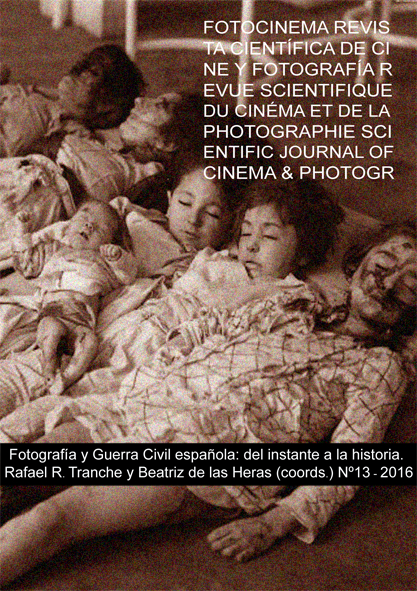Cartografía imposible para un agrimensor: la paradoja de El castillo de Kafka en los filmes de Rudolf Noelte, Aleksei Balabanov y Michael Haneke
DOI:
https://doi.org/10.24310/Fotocinema.2016.v0i13.6061Abstract
El estudio sobre los géneros En este trabajo nos proponemos analizar los filmes de Rudolf Noelte, Aleksei Balaba-nov y Michael Haneke que toman como punto de partida la novela inconclusa El Castillo escrita por el checo Franz Kafka. El corpus seleccionado es aquí entendido no como una simple adaptación o ilus-tración de la novela, sino una interpreta-ción crítica de ésta. Las posibilidades que el texto literario abre a partir de las lagu-nas y saltos temporales y espaciales per-miten a cada uno de los directores traba-jar de forma particular, sin dejar de retra-tar elementos ya presentes en Kafka. Nos detendremos en la construcción de espa-cio, observando en qué medida la violen-cia ejercida sobre el protagonista se plas-ma en cada uno de los textos fílmicos: la dimensión espacial resulta en los tres casos un mecanismo al servicio de la opresión del individuo por el sistema, tópico central kafkiano. Consideraremos aquí no sólo el cambio de soporte, sino además el cambio en los modos de pro-ducción cinematográficos y la distancia entre sus contextos de producción.Abstract:
In this work we attempt to analyze Rudolf Noelte, Aleksei Balabanov y Michael Haneke’s films based in Franz Kafka’s The Castle. The selected corpus is conceived not as a simple novel adaptation or illustration, but as its critical interpretation. Possibilities opened by gaps and by temporal and special leaps allow each director work in a particular way, without abandoning elements already presents in Kafka. We will consider space construction, attending how violence over the main character is expressed in each film: space dimension appears as a mechanism that works for the oppression of the individual by the system, central theme in Kafka. We will consider, not only support changes, but also the ones in cinematographic production and distance between their productive contexts.
Palabras clave:
Construcción espacial; transposición literatura-cine; El Castillo.
Keywords:
Space Construction; Literature-Cinema Transposition; The Castle.Downloads
Metrics
Publication Facts
Reviewer profiles N/A
Author statements
Indexed in
-
—
- Academic society
- N/A
- Publisher
- Universidad de Málaga
Downloads
Published
How to Cite
Issue
Section
License
All contents published in Fotocinema Revista científica de cine y fotografía are protected under the Creative Commons Attribution-NonCommercial-ShareAlike 4.0 International (CC BY-NC-SA 4.0) license. All about this license is available in the following link: <http://creativecommons.org/licenses/by-nc-sa/4.0>
Users can copy, use, redistribute, share and exhibit publicly as long as:
- The original source and authorship of the material are cited (Journal, Publisher and URL of the work).
- It is not used for comercial purposes.
- The existence of the license and its especifications are mentioned.
There are two sets of authors’ rights: moral and property rights. Moral rights are perpetual prerogatives, unrenounceable, not-transferable, unalienable, imprescriptible and inembargable. According to authors’ rights legislation, Fotocinema. Revista científica de cine y fotografía recognizes and respects authors moral rights, as well as the ownership of property rights, which will be transferred to University of Malaga in open access. The property rights are referred to the benefits that are gained by the use or the dissemination of works. Fotocinema. Revista científica de cine y fotografía is published in an open access form and it is exclusively licenced by any means for doing or authorising distribution, dissemination, reproduction, , adaptation, translation or arrangement of works.
Authors are responsable for obtaining the necessary permission to use copyrighted images.














13.png)



